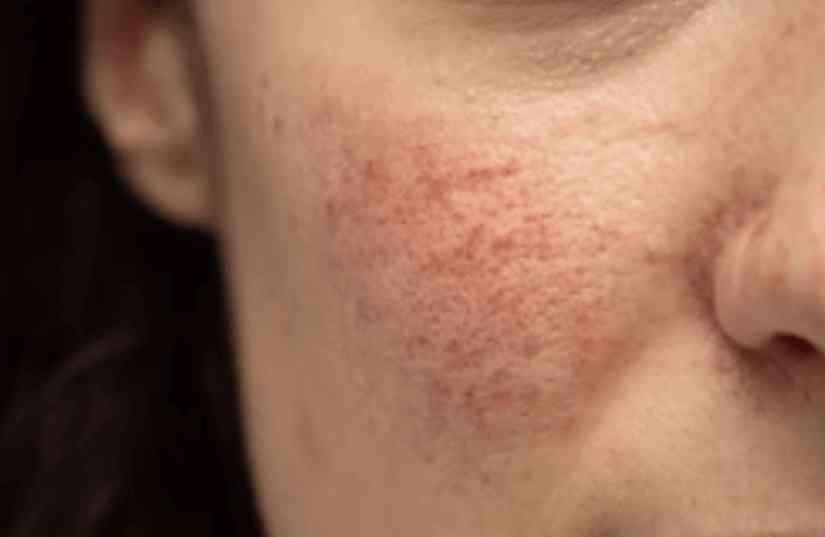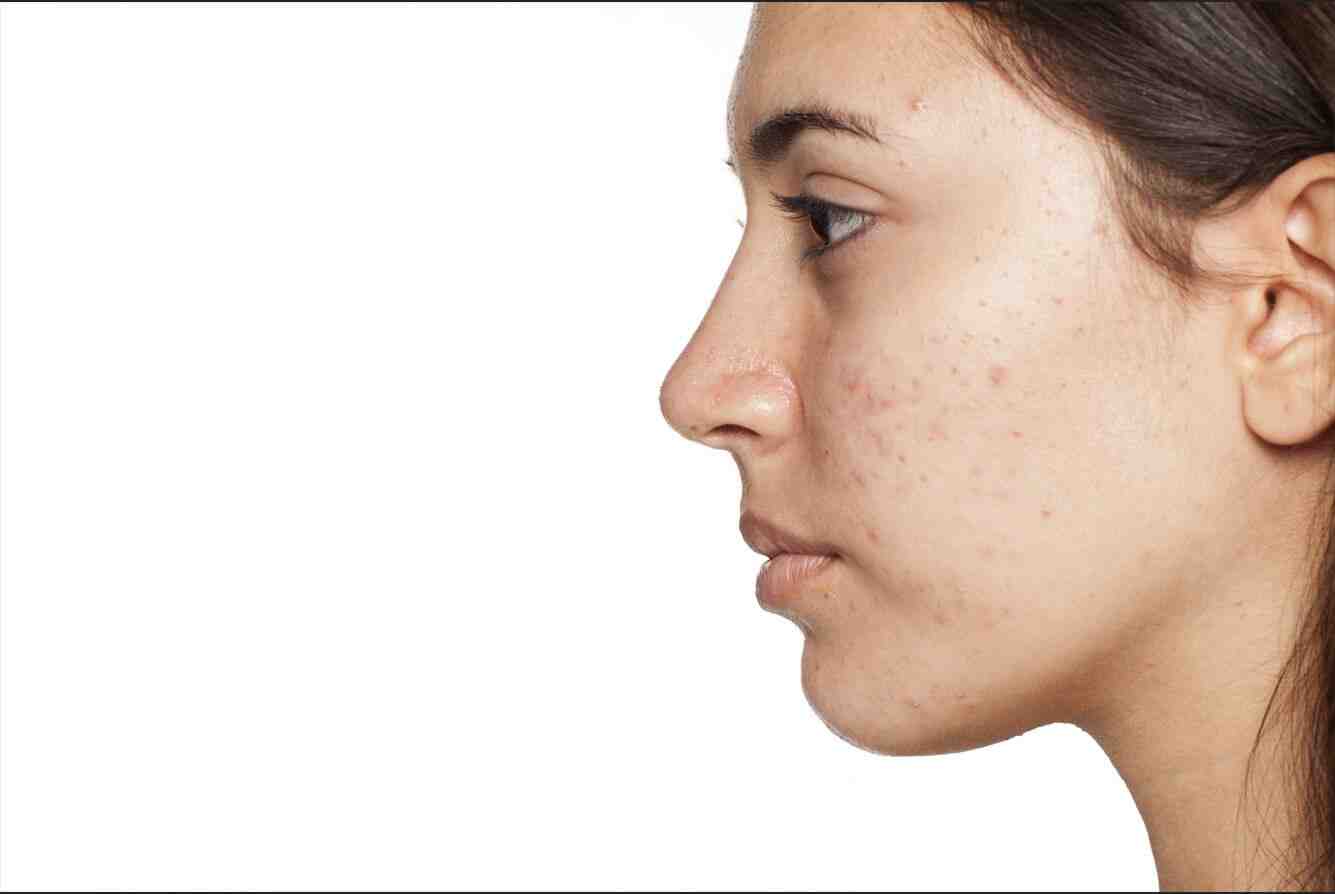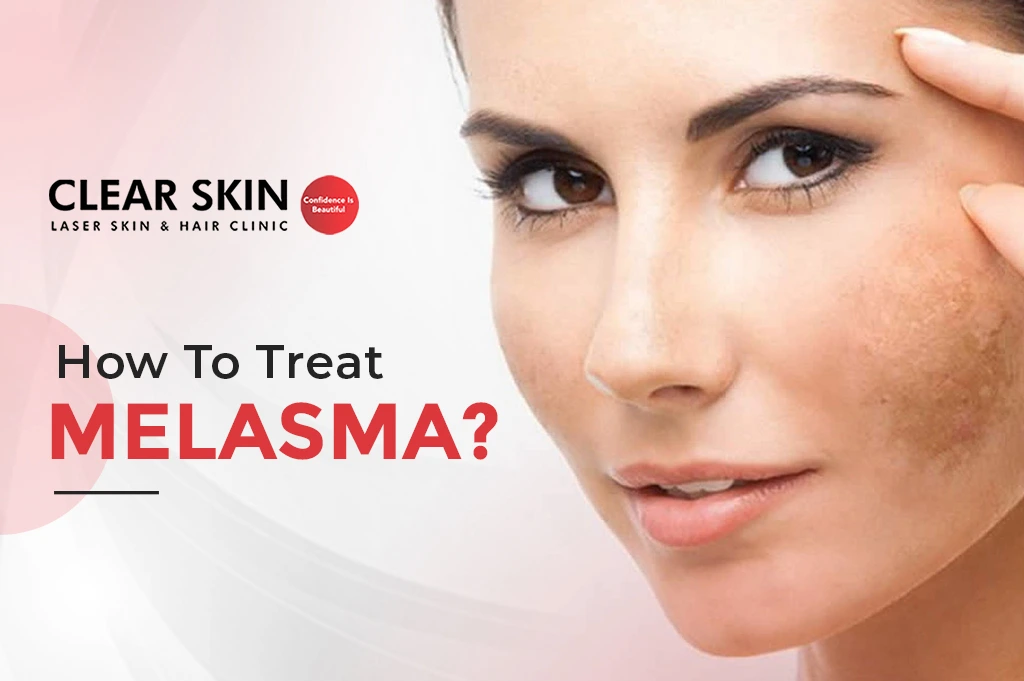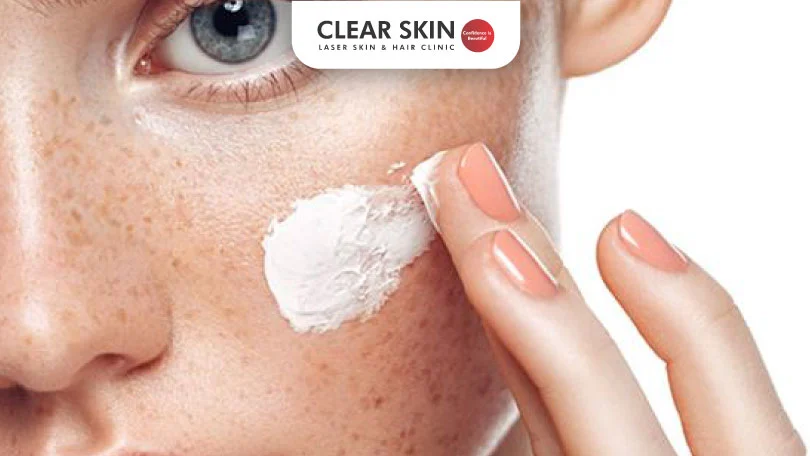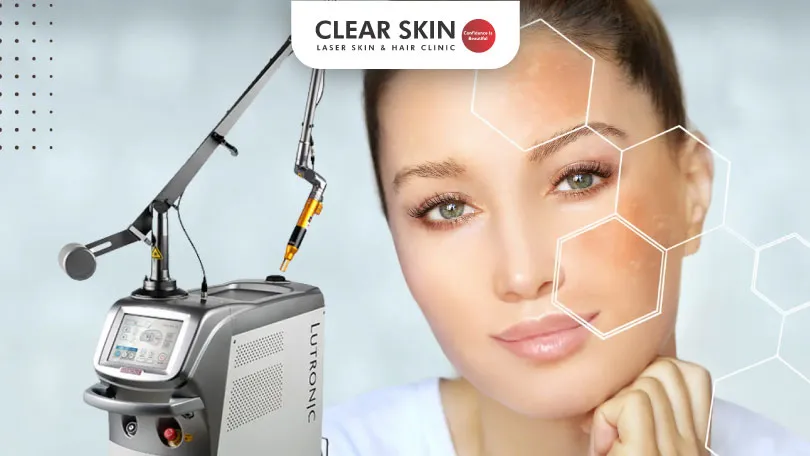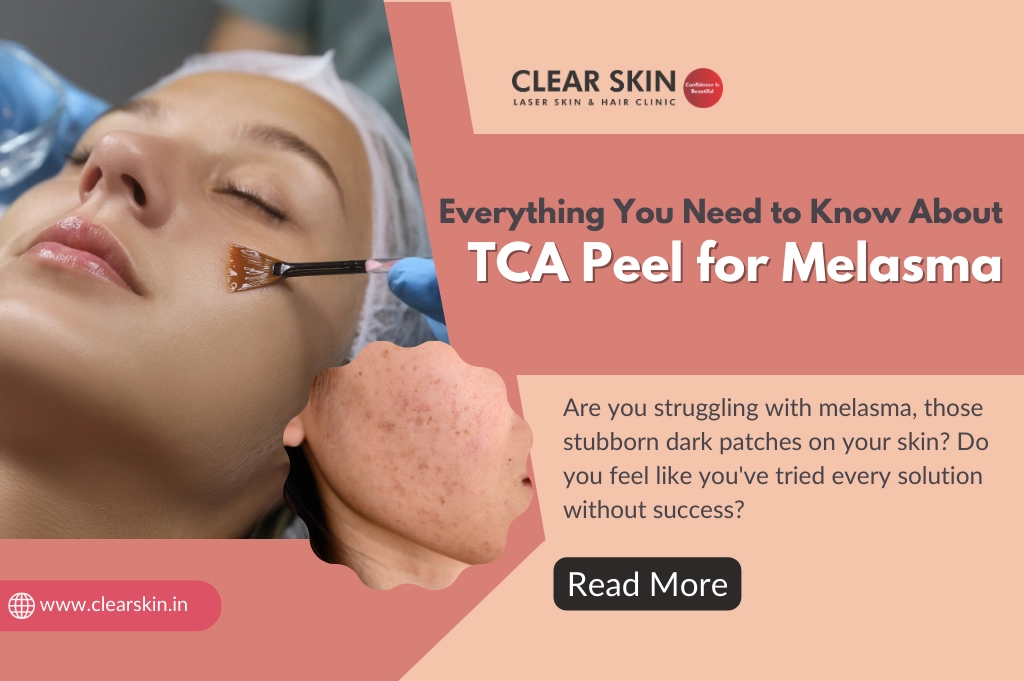Melasma Treatment in Pune
Melasma Treatment is crucial if the disorder causes dark patches to develop on skin that has been exposed to the sun. This is common melasma in darker-skin women, as well as women of reproductive age. Melasma during pregnancy (When it occurs in pregnant women, it is also called the “mask of pregnancy” or chloasma.) It also affects men. The treatment for melasma in men is similar to that for women and may include topical creams, chemical peels, and laser therapy. Melasma cause appears as freckle-like spots forming large, flat, brown patches.
Clear Skin offers specialized melasma treatment options for all skin problems. With affordable pricing, the latest technological advances, and promising results, we offer the best laser treatment for melasma in Pune.
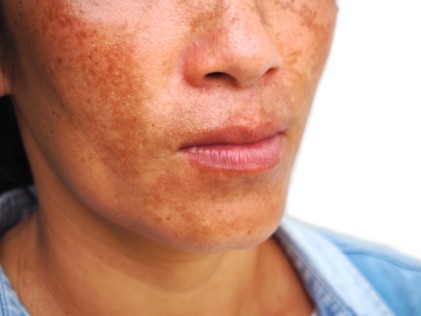
Table of Contents
Melasma in Men: Causes and Treatments
Do’s & Don'ts for Preventing Melasma
Melasma Laser Treatment Cost in Pune
Why choose Clear Skin for Melasma Treatment in Pune?
Causes of Melasma
The pigmentation is a result of the overproduction of melanin. People who tan easily or have naturally brown skin are prone to melasma disease because they have more active melanocytes compared to people with lighter skin.
Melasma skin disease depends on your genetic predisposition. A few of the other triggering factors are:
Sun exposure:
Uncontrolled exposure to the sun is the leading trigger as UV light from the sun stimulates the melanocytes, increasing melanin production.
Hormonal changes:
Internal hormonal changes, as seen in pregnancy, stress, thyroid disorders as well as exogenous hormone treatments in the form of oral contraceptives, intrauterine devices, hormone replacement therapy, are all implicated in the triggering of melasma.
Medications:
Certain medications like anti-seizure drugs, anti malignant drugs could also act as triggers.
Melasma Skin Care products::
Scented soaps, toiletries, cosmetics, and skin care products that irritate the skin. This may increase melanin production and accelerate melasma symptoms.
Melasma in Men: Causes and Treatments
Melasma on Face is a pigmentation disorder that occurs commonly in women. However, melasma in men is also common now. It is characterised by the appearance of dark patches on the skin, mostly on the face or areas exposed to the sun. Although harmless, melasma can lead to lowered self-confidence due to brown hyperpigmentation on the nose, forehead or the entire face. Here is an insight into the causes and melasma treatments for men.
Causes of Melasma in Males
- Overexposure to the sun can lead to the appearance of dark spots or patches on the skin due to the generation of excess melanin. This hyperpigmentation is called melasma.
- Hormonal imbalance is another leading cause of melasma in men. Thyroid disorders can also cause melasma .
- Stress can lead to hyperpigmentation, leading to the appearance of melasma dark patches on face treatment on the skin. This is melasma.
- Some men are genetically more susceptible to hyperpigmentation. So, genetic susceptibility or family history is also a reason behind melasma.
- A less common but important cause of melasma in men is cosmetics. Certain cosmetics with harsh chemicals may lead to the appearance of dark patches on the face.
- Certain photosensitizing medicines can lead to melasma in men.
Treatment for Melasma in Males
- Skin lightening creams and other topical medicines work well to reduce hyperpigmentation caused by melasma.
- Chemical peels are an effective way to treat melasma in males.

- Laser therapy is among the best melasma treatments for men.
- Microneedling is another effective treatment procedure for melasma in males.

- Dermabrasion and microdermabrasion, wherein, some layers of the skin are removed, are among the best melasma treatments.
- Application of aloe vera gel on the affected skin region, keeping the skin well-hydrated and clean, and following a balanced diet are important in preventing the recurrence of melasma. Most importantly, use sunscreen on a daily basis.
Most often, a combination of melasma treatment methods helps give relief from this skin condition. It is advisable to consult a dermatologist, about which melasma treatment(s) would suit you best.
Types of Melasma
Epidermal melasma:
In this condition, excess melanin layers are present in the keratinocytes cells of the epidermis. In fact, this type of melasma has patches with well-defined borders and responds well to treatment.
Dermal melasma
In this condition, known as dermal melasma the excess melanin may be deposited in the inner or deeper layer of skin called the dermis. Moreover, this type of melasma has unclear borders and does not respond well to treatment.
Mixed:
In this condition, melasma and pigmentation occurs in the epidermis as well as the dermis.
Patterns of Melasma
Melasma on face occurs on both sides of the face, indistinct patterns such as -
Centrofacial pattern: This occurs on the forehead, cheeks, nose, and upper lip. This is the most common pattern.
Malar pattern: This occurs on the cheeks and nose.
Mandibular pattern: This occurs on the jawline.
Melasma Treatment Methods
While there is no cure for melasma, many successful melasma treatment options have emerged in current times. Whatever be the most suitable treatment for your skin, it is essential to keep your face and affected areas protected from the sun during and after the melasma treatment. This means when you’re hitting outdoors, or even when inside, you should always wear sunscreen. And this habit must be maintained even after the treatment so as to ensure the melasma skin problems do not re-occur. Melasma Sunscreen will protect your skin against UV rays, a common trigger for melasma that makes hyperpigmentation darker.
Other recommendations include avoiding the use of over-the-counter creams, face washes, and creams that may be an irritant for your skin as this may worsen melasma.
Here are some common skin problem best melasma treatment methods that dermatologists recommend:
Hydroquinone:
Hydroquinones help in reducing pigmentation due to melasma skin disease. They act by inhibiting an enzyme called tyrosinase that is essential for the production of melanin. It is considered a standard treatment for melasma.
Hydroquinone is a lightening or depigmenting topical agent which is available in cream, lotion, gel, or liquid forms. However, it can cause the darkening of skin with overuse at high concentrations for a prolonged period. So should be taken only after a prescription from a dermatologist.
Who should try this?
If used in combination with other agents, its efficiency can further be enhanced. After proper assessment of the skin and diagnosis of the condition, the patient can be started on hydroquinone to treat melasma.
Retinoids :
Retinoids resolve melasma by increasing skin cell turnover and allow fresh cells to form quickly. Tretinoin is the commonly used derivative and is even available in combination with hydroquinone or azelaic acid. It may lead to mild side effects like peeling, dry skin, and irritation.
Who should try this?
This melasma treatment in Pune is great for patients who have melasma on their face, and want to lighten the pigmentation.
Other topical medications:
A range of creams is available for skin lightening. These creams don’t bleach the skin but instead, act on the pigment-producing cells that reduce the darkening of the skin. The most common compounds in these creams are kojic acid for melasma, glycolic acid, Azelaic acid, Arbutin, Vitamin C, and Niacinamide. Tranexamic acid, a procoagulant agent, is another popular medication that is widely used in the treatment of melasma. Its topical (and oral) formulations have shown good results. Remember, the effect of these topical agents is not permanent and requires at least three months to show results. Always wear sunscreen over these creams before stepping out.
Who should try this?
Topical medication is required in all patients with melasma treatment. However, its strength, duration, and choice of topical and oral agents vary, depending on the type and depth of melasma in patients. Those with deeper pigmentation usually require a combination of other treatments in addition to oral and topical medications.
Chemical peels:
Chemicals – which are derived from natural sources like fruits, almonds, and sour milk – are used to exfoliate the superficial layers of the skin. They also help reduce the pigment in the upper layers of the epidermis. The degree of pigmentation decides the concentration of the acid and the number of sessions required. Chemical peeling may cause a few side effects such as irritation, redness, and peeling in a few individuals. (Such side-effects can be minimized or avoided if the procedure is done by a trained and experienced professional.) In the case of deeper peels, you will also need to make an allowance for recovery time after the procedure. The dermatologist will choose the type and strength of the chemical peel best suited to the individual's skin type. Only dermatologists must administer Chemical peels.
Who should try this?
Chemical peels are suitable for candidates who want to improve their epidermal hyperpigmentation. Various melasma peels like glycolic acid, Trichloroacetic acid peel, Retinoic acid peel, or combination peels are used in treating melasma.
It’s worth noting that chemical peels should ideally be used in combination with other treatment options for the faster and better clearance of melasma.
Microdermabrasion:
This non-invasive, non-chemical method of exfoliation uses vacuum suction and abrasive material. Microdermabrasion is usually used in combination with other methods of treatment for better results.
Who should try this?
This treatment is suitable for candidates who are looking to reduce the appearance of fine lines, tanning, and hyperpigmentation that occurs due to melasma, which itself is a result of hormonal changes, sun exposure, and several other factors.
Laser therapy:
Different types of potent lasers have been used for the melasma treatment. These include the Q-switched NdYAG laser. Though they are one of the most effective forms of treatment for melasma with good results, the results have not been consistent. Treatment for melasma with lasers requires skilled and qualified doctors who may decide to couple the treatment with other procedures and creams for maximum effect. The cost of laser treatment for melasma depends on several factors. It is advisable to consult your specialist and understand the best treatment plan for you, which will then decide the cost of the treatment.
Who should try this?
Q switch NdYAG 1064 nm laser for melasma is best suited for people with a dusky complexion, but it’s not recommended as monotherapy. The treatment has to be combined with other procedures like peels and oral medicines for the best results.
Sun protection: Sun protection is one of the most important aspects of the melasma treatment. Always wear sunscreen with an SPF (sun protection factor) of at least 35. The sunscreen should be broad-spectrum, meaning it should offer protection against UV-A and UV-B radiation from the sun. Apply sunscreen at least fifteen minutes before you leave your house and re-apply every two to three hours. Sunscreens can be applied over any topical medication creams.
One way to speed up your melasma recovery process is to have sufficient sun protection during the process. You have to use a broad-spectrum sunscreen, whenever you step out – even on cloudy days. The sunscreen must contain UVA and UVB blocking agents like zinc or titanium dioxide. Patients who want to reduce the appearance of their melasma should take on various methods of sun protection; this includes avoiding sun exposure, as much as possible; especially, during the peak hours of the day. Wear a hat, cover your arms and chest with sun-protective clothes, and seek shade whenever possible.
Do’s & Don'ts for Preventing Melasma
DO: Use a broad-spectrum sunscreen
DO: Use physical sun protection like scarves, jackets, and hats.
DO: Follow a regular skincare routine.
DON’T: Leave the house without sun protection
DON’T: Spend too much time in the heat, saunas, or steam rooms.
DON’T: Take any medication without consulting your doctor
DON’T: Continuing medication for longer period than prescribed by the doctor
Melasma laser treatment cost in Pune:
The average melasma laser treatment cost is between Rs 5,000 to 15,000. However, the cost depends on the severity of your melasma condition, your skin type, and the treatment you choose.
Why choose Clear Skin for Melasma Treatment in Pune?
Clear Skin provides specialized melasma treatment options with the help of a team of qualified dermatologists and the latest technology. Combined treatment plans ensure permanent solutions for your skin problems with advice and follow-up melasma skin care to maintain your complexion. Clear Skin guarantees a lower cost of treatment for melasma with the best available solutions.
Our in-house team of highly experienced dermatologists and cosmetic surgeons use top-of-the-line FDA-approved equipment and holistic treatment modalities to help treat even the most complex skin conditions.
Book Appointment
Melasma Treatments
Melasma Treatment Success Stories

Melasma is a condition in which brown patches appear on parts of the skin exposed to the sun. Melasma skin problem is common in darker-skin women, as well as women of reproductive age. (When it occurs in pregnant women, it is also called the “mask of pregnancy” or chloasma. Learn more about treatment for Melasma on Face.
It works,
Says our Patients

Ajit Pisote
"I was recommended this clinic fr my melasma problem. it hs been few months nw nd i hv been treated by Dr Deepali.... I hv found vast difference in my skin texture nd my melasma marks hv lightened up. I regained my confidence.. thx

Prapti Karandkar
"I am taking treatment for melasma here. Got wonderful results. Thank you Clear Skin.."

Pooja Bande
"Everyone is super friendly here and the treatment results for Melasma are also awesome!! I really recommend this place. ThnQ"

Preeti Chahal
"Doctor diagnosis is nice. She also explained the factors responsible for melasama and pigmentation. "

Priya Barge
"Thanks for the Melasma treatment. I am really thankful to the doctors and everyone in staff for curing it."
Treatment Timeline

























Clear Skin Ultimate Guides
How to Treat Melasma? : Tips and Techniques
Melasma is a common skin ailment that causes dark spots to appear on the face. These patches are caused by an overproduction of melanin, the pigment that gives our skin its colour. While melasma is not dangerous, it can... Read MoreThe Skin Lightening Creams That Actually Work for Melasma
Table Of Contents How Does Skin-Lightening Cream Work for Melasma? Ingredients to Look Into Best Skin Lightening Cream for Melasma Are you tired of dealing with the frustrating and unsightly brown melasma patches on your face? Do you feel... Read MoreThe Benefits of Q-Switch Laser Treatment for Melasma
Table Of Contents Benefits of Q-Switch Laser for Melasma Do you suffer from melasma, the skin condition that causes dark patches on your face? Are you seeking a safe, effective melasma treatment in Pune to reduce its appearance and... Read MoreEverything You Need to Know About TCA Peel for Melasma
Table Of Contents How Does TCA Peel Work for Melasma Treatment? How is TCA Peel Performed? How Long Does It Take to See Results from TCA Peel? How Many TCA Peel Treatments Are Needed? What Are The Risks of... Read MoreClear Skin Insights
Non-Surgical Breast Reduction: Approaches for Smaller Breasts
How to Cope With Itchy Skin After Laser Hair Removal?
How to Get Smaller Breasts in 1 Week: Effective Tips and Strategies
Hydra Facial Treatment, Procedure & Why it is popular? | Clear Skin, Pune
FAQs
Melasma is a result of pigmentation on the skin, caused by the overproduction of melanin by the pigment cells of the skin called melanocytes. It is a chronic skin condition that results in symmetrical, brownish, blotchy face pigmentation. Thankfully, there are various treatments and therapies that work to cure the skin condition.
The most popular form of treatment for melasma is the use of chemical peels. Usually, a chemical peel costs between Rs. 2000 to Rs. 5000 through a good clinic. Some dermatologists might also require a combination of chemical peels, depending upon the intensity of melasma on your skin.
You should consult a dermatologist near you and get a skin analysis conducted to figure out the exact treatment for melasma. Ensure that you only visit a board-certified dermatologist who can diagnose a proper treatment for you without any discomfort to your skin.
Melasma is a common skin condition that occurs mostly in women, especially during pregnancy. It appears as coloured spots or blotches on the skin and occurs due to the overproduction of melanin. It can also be caused due to sun exposure, climate changes and could also be hereditary in a few people.
It can be seen as freckle-like spots on the face. However, there are various treatments that can help treat and bring melasma under control,
- Chemical peels on the surface or in-depth layers of the skin that help to exfoliate dead cells, hydrate the skin, and give a rejuvenized look.
- Laser treatments that reduce the excess melanin production and help to counter pigmentation in the skin
- Trichloroacetic acid treatments – This treatment is most common in treating melasma. This treatment can give the best results.
- Some oral and topical medications can help ease the texture of pigmented skin
- It is necessary that those suffering from Melasma apply sunscreen frequently and avoid sun exposure as much as possible. Sunscreen must be applied even while at home.
Always consult a dermatologist before trying out any of these treatment procedures as he or she can recommend the best remedy for your skin type. With constant checkups and treatment for your skin, you can get the best results in about 4-6 months.
Melasma is a chronic form of pigmentation in the skin that appears as spots or blotches. It can start in the early 20s and last up to your 40s. Usually seen in more women than men, it can make the skin sensitive to the Sun due to the overproduction of melanin by the pigment cells(melanocytes) during sun exposure.
Melasma on the skin can be of the following types:
- Epidermal melasma has a well-defined border & it is in dark brown color. This melasma responds very good to the line of treatment.
- Dermal Melasma, is located in the dermis of skin & has faded borders. This pigment is light brown or bluish in color. Being deeply seated, it responds poorly to the treatment.
- Mixed Melasma, the most commonly found as Light brown, dark brown, bluish pigmentation on the skin. This improves partially with the treatment.
Melasma can also be triggered due to various reasons including pregnancy in women, overexposure to the Sun without adequate protection, consumption of oral contraceptives, thyroid, etc.
In order to treat melasma, consult a board-certified dermatologist to recognize the exact cause and procedure for the same. Your dermatologist can suggest topical creams to improve the skin’s texture. Skin treatments containing Vitamin C, arbutin, kojic acid, azelaic acid and niacinamide will also help treat pigmentation. Additionally, you need to apply sunscreen with SPF 30 or higher as well as PA+++ rating (PF indicates protection from UVB rays while PA implies protection from UVA rays) to fight free radicals in the skin.
In any case, the treatment of Melasma is individualized. Every patient of melasma needs to be treated differently depending upon a level of pigment & type of skin. Multiple treatment modalities should be used to get the best outcome rather than monotherapy.
Melasma is a result of skin pigmentation, which can be caused due to many different reasons. For some, it’s hormonal or due to overexposure to the Sun. For others, it can be genetic. Many women also face melasma during and after pregnancy. Despite the reason for its occurrence, it needs to be brought under control through various types of treatment methods including laser treatments, chemical peels, along with topical applications and oral medications.
This skin condition takes almost 4-6 months to fade but may differ from person to person. Around 60% of patients get promising results from the first day of treatment. 20% take a gradual pace in showing improvements whereas the remaining 20% don’t show any improvements at all. It takes about 5 to 6 sessions of treatment to determine whether the melasma condition is responding to the treatment. With continuous treatment, medicines, and care for your skin as recommended by your dermatologist, you can treat melasma effectively.
Melasma is a form of pigmentation caused by the overproduction of melanin in the skin. It appears as freckle spots and blotches in darker pigments and is commonly known as butterfly Rash, chloasma faciei or mask of pregnancy.
Appearance of melasma
- Face
- Cheek
- Nose
- Bridge of the nose
- Forehead
- Upper Lip
- Rarely over shoulders and neck
Anyone who has a hereditary or hormonal predominance of pigmentation can get melasma. It can also occur due to Sun exposure without protective clothing and weather changes. Melasma is more common in females. Only 10% of male patients get melasma.
Triggering factors for Melasma
- Sunlight
- Hormonal changes
- Few cosmetic irritant products
- Oral contraceptive pills
Melasma treatments
- Use sunscreen regularly with SPF30 or higher. Apply it 15 minutes before stepping out. Repeat the application every 3 hours, even when at home.
- Local application of various creams like hydroquinone group, tretinoin group other depigmenting creams & oral medications
- Chemical peel
- Microdermabrasion
- Skin Polishing
- Fractional Q switch ND-Yag laser (Q switch laser)



